Note: The following article is the first part of an ongoing “Oregon Experience” documentary production and story series examining some Northwest tribal members’ experiences with Native American residential schools. It contains descriptions of child abuse along with racist policies and quotes with archaic language.

This image, circa 1890, shows students at the Klamath Agency boarding school on the Klamath Indian Reservation.
Courtesy of Gabriann Hall
One hundred and fifty years ago, the Klamath Indian Reservation encompassed over one million acres of rugged mountains, forests and wetlands stretching through Southern Oregon’s Klamath Basin.
As part of the 1864 treaty with the U.S. government, just over 900 Klamath, Modoc and Yahooskin-Paiute people lived confined to the reservation. The government had promised, among other things, to provide their children with an education.
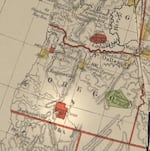
This 1878 map shows the Klamath Indian Reservation.
Courtesy of University of Wisconsin-Madison Libraries
However, a regularly staffed school wasn’t open until February 1874.
It was a live-in boarding school situated on the Klamath Agency, the headquarters of the federal Indian Agent in charge of the reservation.
That meant to get an education, Indian parents had to send their children to live at the Agency school.
In an annual report, Klamath Agent Leroy S. Dyar mentioned the new school in a single paragraph, stating that by the end of the year, 25 students had enrolled. Dyar doesn’t list the student’s names, ages or their tribal affiliations.
1874 diary details reservation life
Personal writing offers more insight. John Kuykendall, a 54-year-old carpenter who lived and worked at the Agency, kept a diary that year. Today, its transcripts are held at the Oregon Historical Society.
Kuykendall wrote on Feb. 2 that the boarding school “Commenced this morning with some 10 or 12 boys & 2 girls. The teacher feels quite encouraged with the prospect.”
Over the next few months, Kuykendall described the severe winter weather and how a stovepipe fire burned the new school’s roof. He noted when the school closed for summer break on July 19 and how he made a sled for the students to enjoy at Christmas.
He also reported on the death of children during a measles outbreak, writing on April 13, “Little Ivy is still quite sick and needs watchers. Ma & I are going to sit up with him.” The following day, Kuykendall reported, “Dear little Ivy is gone from us.”
A complex, complicated and controversial history
Government-funded residential schools for Native Americans, often called Indian Boarding Schools, operated for decades and enrolled tens of thousands of Indigenous children across the United States. A few, including Chemawa Indian School in Salem, remain open today, though with a different mission.
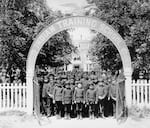
This undated photograph shows students at the Chemawa Indian Training School in Salem.
Courtesy of the Oregon Historical Society
As Native Americans were forcibly moved off their lands and onto reservations, the federal government used schools as a way to assimilate Native people into mainstream white society by stripping them of their language, culture and land — often by force.
In 1876, Dyar wrote in a monthly report that keeping students in the Klamath Agency school “requires constant vigilance.” He wrote that he sometimes had to “exercise authority” to “prevent children from leaving, or the parents from drawing them away.”
Indian Reservation agents working for the federal government had the authorization to withhold food rations and supplies to tribes that did not send their children to school.
An era of forced assimilation
In 1884, ten years after the Klamath Reservation boarding school opened, buildings were expanded to accommodate additional students, while a second residential school opened in the southeastern section of the reservation at the Yainax sub-agency about 30 miles away. Altogether, the two schools could accommodate over 100 students.

This photograph from 1890 shows students at the Yainax boarding school on the Klamath Reservation.
Courtesy of the Klamath County Museum
That year’s federal report outlined how three hours of each school day focused on academics, while students spent five hours on “labor and industrial pursuits.” The report stated, “The girls are taught all that pertains to housekeeping and making and repairing school clothing, and the boys the various kinds of farm work.”
Across the country, some people argued that students lived too close to their families. Students often left school to return home, or parents removed their children, especially during important hunting or harvesting seasons. An 1872 report stated: “If the Indian children are allowed to reside and grow up with their savage parents while attending school, they will naturally absorb their parents’ habits … which do not harmonize or assimilate with the education received.”
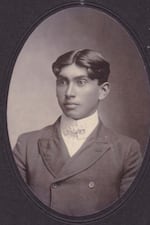
This image, circa 1900, shows Modoc student Joe Ball from the Klamath Reservation, who ran away from the Carlisle Indian Industrial School.
Courtesy of Gabriann Hall
In 1879, the nation’s first off-reservation Indian boarding school opened in Carlisle, Pennsylvania, with a clear agenda of removing children from their families and culture while immersing them in the English language.
In 1900, when a group of nine Klamath students were sent to Carlisle, two soon ran away. Joe Ball and Clayton Kirk made it almost 200 miles before being captured.
‘Kill the Indian; save the man’
The Carlisle Indian Industrial School founder and longtime superintendent Richard Pratt operated the facility following the philosophy of his famous words: “Kill the Indian in him and save the man.”
Children were forbidden to speak their Native language or wear their traditional clothing; instead, they wore uniforms. They were often assigned English names, their hair was cut short and they lived in barracks while following a rigid, military-inspired routine.
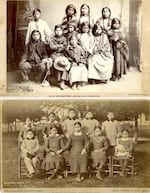
These two images of Forest Grove Indian School students from the early 1880s are an example of propaganda "before and after" images schools often produced. One of the students in the earlier photograph had died by the time the second image was taken seven months later.
Courtesy of the Pacific University Archives
In addition, the students’ duties included running the facility’s daily operations. That could include sewing student uniforms, doing laundry, cooking meals for students and staff, tending to the farm and other jobs generally done by paid employees.
The National Native American Boarding School Healing Coalition has identified more than 500 government-funded Indian boarding schools across the country, with at least 12 located in Oregon — including the nation’s second off-reservation boarding school in Forest Grove.
Oregon builds the nation’s second off-reservation boarding school
The Forest Grove Indian Industrial Training School opened in 1880. According to Pacific University archivist and researcher Eva Guggemos, of the 310 students enrolled between 1880 and 1885, at least 11 students died while at school, with many others sent home sick. The most common cause was tuberculosis.
In 1885, the school moved to Salem with 19 new students from the Klamath Reservation. Guggemos’ research shows that within months, at least three of them died at the school.
By 1887, Klamath Superintendent Joseph Emery reported that eight of those students had died, writing, “This great mortality has caused much dissatisfaction … and any effort to remove more children to this school will meet with serious opposition on the part of the Indians.”

This image from 1881 shows Forest Grove Indian Training School, which moved to the Chemawa location in 1885.
Courtesy of Pacific University Archives
Contagious diseases like measles and tuberculosis ran rampant through crowded boarding schools for decades. Inadequate facilities and medical care, heavy workloads with little time for rest and poor nutrition led to frequent deaths.
Many schools maintained cemeteries to bury their dead students.
A system of abuse, mistreatment and neglect
A federal inspection of the two Klamath Reservation boarding schools in 1890 gave a scathing report, saying that one of the teachers “is in no way qualified for her position” and recommending firing the superintendent and his wife. “Their punishments were frequently severe to the verge of cruelty … they should not be allowed to have unlimited control over children of any race.” Enrollment records show that some students were as young as six years old.
The following year, reports stated that the school superintendent “resorted to shackles in extreme cases” while the matron inflicted “scars on different parts of the bodies of school girls, and even upon their faces and heads.”
Throughout the boarding school system, both student accounts and official documents report mistreatment, abuse and neglect.
In 2021, Secretary of the Interior Deb Haaland launched the Federal Indian Boarding School Initiative to conduct a comprehensive review of federal boarding school policies.
The agency’s first report, issued in 2022, found “Rampant physical, sexual and emotional abuse; disease; malnourishment; overcrowding; and lack of health care in Indian boarding schools.” A second report is due early this year.

This image, circa 1920s, shows boarding school students on the Klamath Reservation.
Courtesy of the Burke Archives, Columbia University
Student resistance closes school
The Yainax boarding school closed in the 1910s while a day school continued. In the 1920s, the Klamath Agent reported resistance to the Indian schools and advised their closure.
Then, in March 1927, a fire destroyed the girls’ dormitory at the Klamath Agency. Five girls between the ages of 11 and 17 confessed to starting the blaze in the basement. The Evening Herald newspaper stated, “It is supposed that (the girls) were nettled at Agency school authorities.”
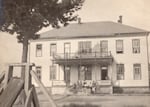
This image from 1907 shows the girls' dormitory at the Klamath Agency boarding school. Five students confessed to burning it down in 1927.
Courtesy of the Southern Oregon Historical Society
The school never reopened. Many students went to public schools both on and off the reservation.
Still searching for answers
However, a federal report showed that in the 1934 school year, 60 Klamath children attended Catholic boarding schools. Records from religious schools are not generally available to the public.
On February 5, 2024, the House introduced the Truth and Healing Commission on Indian Boarding Schools Policies Act, which would best establish a federal commission that would conduct a full inquiry into the assimilative policies of U.S. Indian boarding schools.
“Oregon Experience” behind the scenes

“Oregon Experience” is currently working on a one-hour documentary on the history of Indian Boarding Schools in Oregon, focusing on the personal journey of Klamath Tribal members as they uncover their families’ long hidden and often painful stories.
We will also examine the legacy of resilience and perseverance as modern tribal members embrace traditional language and culture.
Over the next few months, we will provide articles, images and short videos documenting our progress.
Related: OPB coverage of Chemawa Indian School
